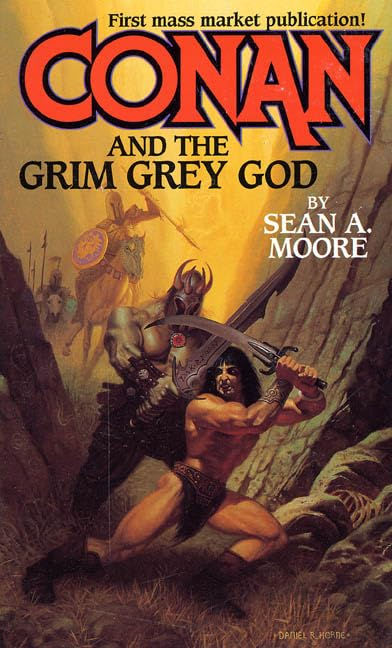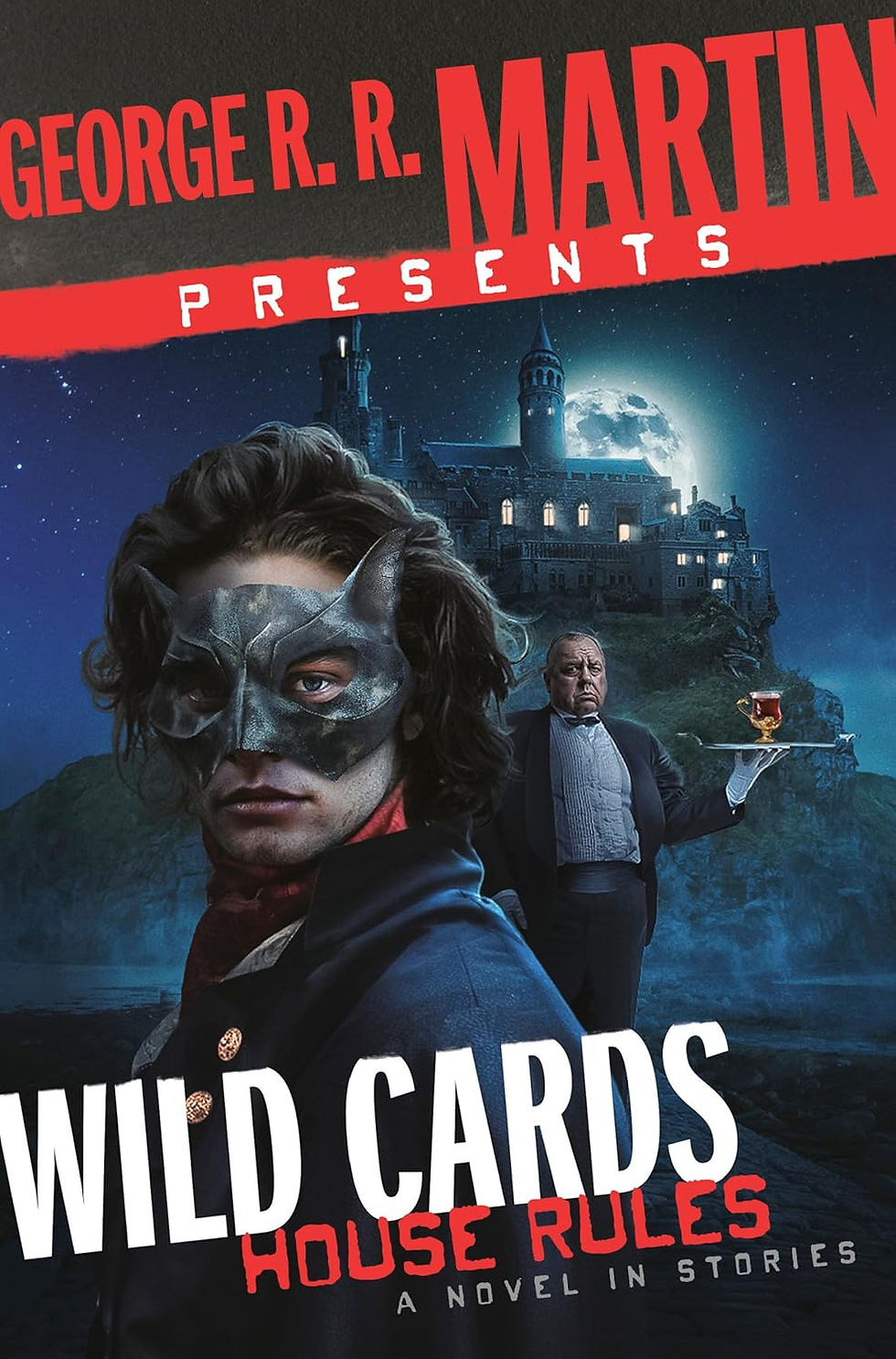But Who Will Avenge This Book?
- cyborgcaveman
- Feb 15, 2023
- 5 min read
Updated: Aug 21
CONAN THE AVENGER by L. Sprague DeCamp and Bjorn Nyberg

Tenth book in the Conan paperbacks from Ace Fantasy, Conan the Avenger centers around the barbarian's quest to rescue Zenobia, his wife and queen, from the clutches of a Khitan sorcerer. Don't let the credits on the cover fool you. Robert E. Howard is given first billing, but the only thing he actually wrote is the essay in the afterward. So, understanding this isn't written by Howard himself (not a posthumously-completed fragment nor even a retooled Howard tale with the character and setting changed to Conan and the Hyborian Era) and therefor a lesser work, let's dive in, shall we?
Following Howard's Conan the Conqueror (also known by its original title Hour of the Dragon), Conan the Avenger is a tale from the days of the barbarian's kingship. Opening with a royal banquet, Conan chafes at the boredom and ceremony of court life. Thankfully, the reader doesn't have to. Within a few pages, Queen Zenobia is snatched off a balcony by a winged demon and Conan sets out in pursuit.
De Camp and Nyberg make sure Conan explicitly tells his underlings (and the reader), "From this hour, I am no longer your king until I return with my stolen queen." This is good, because-- let's face it-- King Conan is kind of boring. Yes, it would make more sense to use the full resources of his kingdom's spies, scouts, and armies to recover Zenobia, but it makes for a dull story.
What follows is a Greatest Hits compilation of very traditional Conan themes. Conan is lured into an ambush by a beautiful woman in distress. He encounters old enemies and old friends, including the wizard Pelias from Conan the Conqueror. He once more assumes leadership of the Zuagir nomads and the pirates of the inland Vilayet Sea. He escapes a dungeon. He kills a giant ape-like monster, a dinosaur-like dragon, and eventually the winged demon from the first chapter. De Camp and Nyberg even have Conan put an end to the lurking threat of King Yezdigerd, the cruel and energetic warlord of Turan, an often mentioned, but unused presence from the original Howard stories.
All the familiar beats are hit, and the story moves briskly enough that you can overlook its structural and editorial flaws. Howard purists and De Camp haters won't find much to like. Conan fans that just want more of the Cimmerian's blood-soaked shenanigans will be happy enough. Fans of Edgar Rice Burroughs might also enjoy it-- if it weren't for one little thing.
Burroughs's Tarzan was always curiously devoted to his Jane, so much so that the author once tried to kill her off (presumably to open up new romantic possibilities for the ape man). Fan outcry required Burroughs to do some literary backpedaling in his next book to resurrect Jane. Obviously, some find the ape man's marriage a selling point. Personally, Jane always got on my nerves. Even as a boy I was more intrigued by La, sinister high priestess of Opar.
Anyway, Conan was always a lustier character than Lord Greystoke. Something of a prehistoric James Bond, the barbarian typically had a new girl for every adventure. Also like Bond, Conan's first "wife", Belit the Pirate Queen, was killed. Until Zenobia, Conan seemed to have no intention of ever settling down again.
I freely admit I could be mixing up the Marvel comics with the paperbacks here, but upon marrying Zenobia, Conan disbanded his harem and devoted himself to his wife. This is all part of his "primitive code of barbarous chivalry" that is so often mentioned. At first, Conan is Tarzanishly monogamous. Once Zenobia is whisked away by the Khitan sorcerer's demon, our hero seems to subscribe to a Hyborian Era version of the rule "if you aren't in the same area code it isn't considered cheating." Zenobia was spirited off to Khitai, which would be several area codes away.
Conan, and the reader, are eased into it by stages. Until he realizes she duped him into an ambush, Conan had intended to receive "at least" a kiss from the treacherous maiden at his first stop. Later, reunited with Yasmina, the Devi of Vendhya, Conan spends a night in her bedchamber without a second thought. This is understandable. The Devi was previously "the girl that got away" in one of my favorite Conan tales, "People of the Black Circle". Less understandable, but highly amusing, is their second bout of lovemaking, just after Conan kills five assassins out to usurp the Devi's rule. They tumble back into bed without even bothering to have the dead bodies removed. I'm pretty sure Conan was also still covered with his enemies' blood. Maybe he wiped off with a sheet?
By the time Conan reaches the borders of Kithai, his dalliance with Kang Lao-dse, the "slant-eyed" and "saffron-skinned" noblewoman he saves from a dragon, barely rates a sentence. She gives him "a woman's reward" for saving her life. I don't find any of this out of line with Conan's character, but it is an interesting divergence from the chivalrous monogamy appended to him by writers of his comic books.
Shortly after his final extramarital romp, Conan finds a household of nobles deposed by the evil wizard. They hatch a plan to sneak into the capitol and take the sorcerer unaware, aided by the usual improbable luck and briefly described battles that typify an author trying to wrap things up. One last, brief battle (in the epilogue of all places!) gives Zenobia a chance to show off her archery skills and save Conan's life. Presumably this is a belated attempt to make her something more than a shapely McGuffin chained to a sacrificial altar.
If I seem to be judging De Camp and Nyberg's work too harshly, well, maybe I am. Robert E. Howard set the bar very high for this kind of tale, especially one featuring his most recognizable creation. Howard's writing painted each scene with blood and thunder. De Camp and Nyberg show a certain dull repetitiveness with their wording and descriptions. Calling a monster an "engine of destruction" twice in the space of two paragraphs is bad writing, bad editing, or both. I was rolling my eyes by the second time I read "Not so Conan!" to explain the difference between our hero and some lesser man that would have died or dropped from exhaustion. Howard certainly used his share of elemental and animal descriptors for Conan (wolves and tigers were always favorites) but somehow De Camp and Nyberg's land with a thud. Watch out for Conan's "gorilla-strong" grip!
That said, don't take this to mean it was awful. It wasn't. I'd much rather read something like this than the next big ten-volume, Chosen One vs. Dark One franchise. For all their faults, De Camp and Nyberg will get you there in just one slim book.



Comments